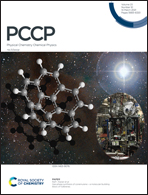Ferromagnetic TM2BC (TM = Cr, Mn) monolayers for spintronic devices with high Curie temperature†
Abstract
Transition metal boro-carbide (TM2BC) structures crystallize in the layered orthorhombic structure in their bulk phases. In this study, however, we find that TM2BC (TM = Cr, Mn) prefer a tetragonal (t) crystal structure in their monolayer phases due to the occurrence of strong sp2 bonds between the metal and B/C atoms instead of sp3 + sp2 bonds which exist in the orthorhombic phase. The calculated energy difference between the orthorhombic and the tetragonal structures based on density functional theory (DFT) is more than 1 eV per unit cell. In addition, t-Cr2BC and t-Mn2BC monolayers are dynamically and thermally stable with their magnetic metal electronic structures. For further investigations, we combine our DFT calculations with the Monte Carlo simulations and find that both t-TM2BC monolayers show ferromagnetic properties. The calculated Curie temperatures are 846 K and 128 K for t-Cr2BC and t-MnBC sheets, respectively. In addition, we examine the magnetic anisotropy energies (MAE) of t-TM2BC monolayers and find that both structures prefer out-of-plane as the easy axis magnetization direction and the applied electric field can easily modulate the MAE of the monolayers. Our theoretical calculations reveal that t-TM2BC (TM = Cr, Mn) sheets have great potential for the future design of controllable spintronic devices with their tunable MAE properties.



 Please wait while we load your content...
Please wait while we load your content...